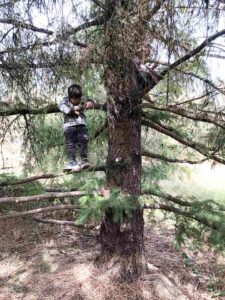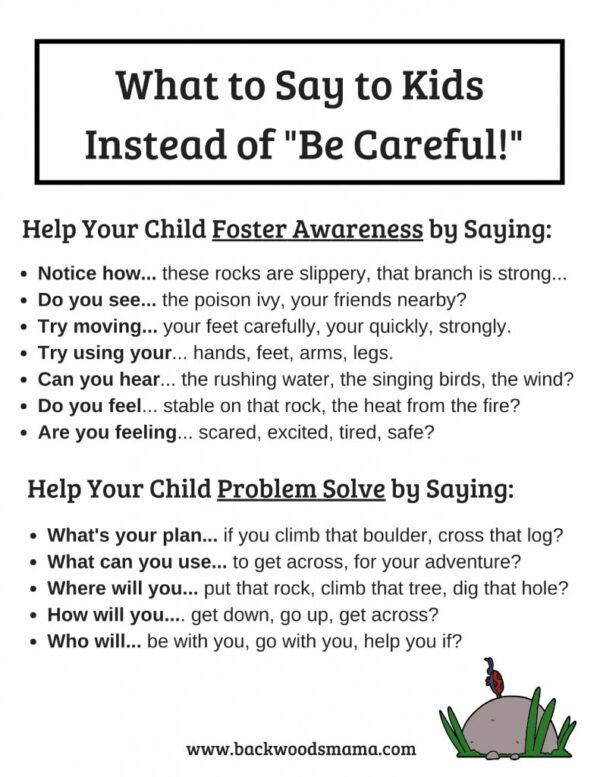Guest Blog Post by Amy Nelson with Outdoor Education Adventures
 Some of my favorite childhood memories involve climbing trees. I loved pushing my limits to see how high I could climb. Chances are many of you were tree climbers too. As caregivers for kids, seeing them climb high in a tree can bring on feelings of anxiety or worry. How can we give our kids the same feelings of independence, pride and connection to nature that tree climbing brings while still helping them assess risks and keeping them safe?
Some of my favorite childhood memories involve climbing trees. I loved pushing my limits to see how high I could climb. Chances are many of you were tree climbers too. As caregivers for kids, seeing them climb high in a tree can bring on feelings of anxiety or worry. How can we give our kids the same feelings of independence, pride and connection to nature that tree climbing brings while still helping them assess risks and keeping them safe?
Did you know tree climbing is banned in all US National Parks? Many city and state parks also have implemented rules against tree climbing. And, in Portland, it’s considered an “unlawful use of trees” to climb in them! The primary reasons for banning tree climbing are to limit damage to the trees and to prevent lawsuits. Despite the growing number of rules and regulations against tree climbing, it offers so many benefits. We learn problem solving, risk assessment, resiliency and get physical exercise all while connecting with the natural world. When approached safely the benefits certainly outweigh the risks.
When kids are climbing in a tree they get stronger physically and mentally. They’re learning what their body is capable of and are able to push their limits. They’re building dexterity and overall physical strength. It’s important to note that children must be able to climb up and down independently, adults should not help kids get in a tree. If their body is strong enough to get up there, it is safer for them to go there.
Climbing a tree is a great way to develop problem solving skills. While in a tree we have to make choices about which path to take, which branch to climb to. When we’re stuck we have to think through the different available routes and determine which is safest. When children are able to work through these problems on their own, (or with gentle support from an adult) they are able to exercise independence and gain confidence.
There is always risk involved in tree climbing, as there is risk in every journey of discovery. We can help kids assess those risks by teaching them to think critically while in the tree. Beginner tree climbers should learn to keep 3 points of their body, (2 hands and 1 foot or 2 feet and 1 hand) securely on the tree at all times. They should also learn to test each branch before putting their full body weight on it. Generally speaking, if a branch is as thick as your arm, it can bear your weight. Branches can be tested by using the 1 free point to put some body weight on the branch. If the branch cracks or moves significantly, it’s not safe to put the rest of your body weight on it.
While climbing in a tree we’re also developing a relationship with that tree. We’re naturally learning the fundamentals of botany; how the branches align, the tree’s growth pattern, leaf shapes and growth patterns, sensing what the bark feels like, what it smells like. We may notice other creatures crawling on the tree, nesting in its branches or running up its side and the relationships between those creatures. Climbing high gives us a different perspective on our environment. We’re able to see our place in a new way.
Here are some helpful phrases to support your young tree climbers.
Focus on what you’re doing.
Does that branch feel strong?
How do you know that branch is strong?
What’s your next move?
Do you feel safe?
I’m here if you need support.
Take your time.
If the urge to shout “Be Careful” arises try one of these helpful phrases from Backwater Mama’s blog instead.


ABOUT THE AUTHOR— AMY NELSON
Amy Nelson is a naturalist and outdoor educator at Maple Grove Nature School. She believes all children are inherently curious, innately connected to the natural world, and benefit from unstructured outdoor play.


